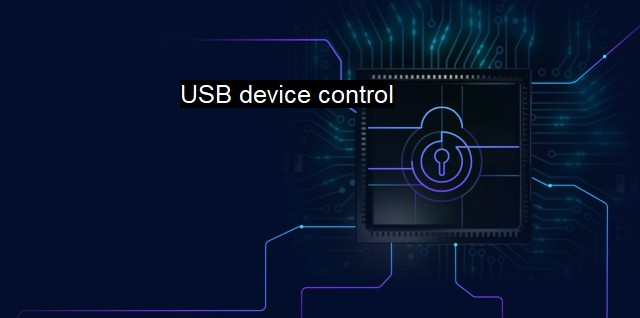What is USB device control?
USB Device Control: A Vital Aspect of Cybersecurity in Today's Digitally-Connected World
USB device control or USB port control is a key aspect of cybersecurity strategies in organizations, primarily designed to regulate the use of USB devices in IT infrastructure. With the rise in potential data security risks and vulnerabilities with removable storage media, controlling the usage of USB devices has become greatly crucial to ward off any possibility of data theft or introduction of harmful malware into the network.USB device control works by managing the USB ports on a computer system or a network and establishing rules about their use. These rules may vary from not allowing any devices to be connected to allowing only specific devices or particular types of data to be transferred. Certain sophisticated control mechanisms can also monitor real-time data transferred through USB ports, flagging and suspending any suspicious activities, ultimately safeguarding the data against unauthorized interference.
One of the main concerns in the cybersecurity environment that USB device control mitigates is the threat posed by malware and viruses. USB devices, due to their portable nature, are frequently used across multiple systems, consequently increasing the chances of virus transmission. In absence of USB control, a malware-infected device can rapidly compromise an entire network just by connecting to a single system. This malware can range from harmless adware to dangerous ransomware which can encrypt entire hard drives until a ransom is paid.
Implementing USB device control allows organizations to monitor and restrict this potential vector for malware transmission. Sophisticated control systems can be set up to scan USB devices upon connection, checking for known forms of malware and either quarantining or deleting potentially troublesome files. By integrating with antivirus software, these control systems provide a robust mechanism to supervise data movement, detect malicious activities, and ensure safe use of USB devices within an organization’s infrastructural framework.
In addition to malware threats, another major concern addressed by USB device control is the prevention of data breaches and data loss. Malevolent insiders or intruders can misuse the straightforward process of uploading, downloading, and transferring files through USB devices, leading to the theft of sensitive and valuable data. USB device control ameliorates this concern by managing access rights and permissions, thereby monitoring the types of data being transferred. Suspicious file transfers can be blocked or flagged, ensuring the integrity of confidential data.
With an applicable USB device control policy, all the activities related to USB usage can be logged for auditing and analysis. This enhances the transparency and accountability of users, which contributes to deterring harmful behaviors and identifying aberrant patterns that could suggest vulnerability exploitation.
While it is easy to overlook the necessity of USB device control considering the widespread use of cloud storage and network file sharing, the risk will remain pertinent as long as USB devices continue to serve as portable and convenient data storage alternatives, and security loopholes continue to exist. Consequently, organizations aiming for robust cybersecurity infrastructure must regard USB device control as a critical component.
Although for an effective implementation, organizations must absolve an all-or-nothing approach while deploying their USB device control policies. Given their intensive use and operational utility, completely disabling USBs could inhibit productivity. Therefore, a flexible system that allows limited and monitored use and incorporates automated alerts can deliver protection without hindering operations.
The establishment of effective USB device control policies, incumbent with comprehensive cybersecurity strategies, is an indispensable step towards safegaurding an organisation’s digital data assets from the evolving security threats. By limiting device access, scanning for malware, and maintaining transfer logs, these controls provide organizations with the means to prevent the harmful use of USBs, ensuring a secure and unruffled operational atmosphere.

USB device control FAQs
What is USB device control?
USB device control refers to the implementation of policies and procedures to secure and manage the use of USB devices by users within an organization. This includes monitoring and controlling access to USB ports, preventing unauthorized data transfers, and protecting against malware infections.Why is USB device control important for cybersecurity?
USB devices can be a significant risk to cybersecurity as they can carry malware that can infect computer systems or steal sensitive data. Implementing effective USB device control measures can help to prevent such risks and ensure the security of organizational data.What are the benefits of using USB device control software such as antivirus programs?
USB device control software such as antivirus programs can provide a range of benefits for organizations, including real-time protection against malware infections, scanning of incoming and outgoing data transfers, and configurable security policies to manage and control the use of USB devices.How can organizations ensure that their USB device control policies are effective?
To ensure that USB device control policies are effective, organizations should regularly review and update their policies and procedures based on changes in the threat landscape and business requirements. This includes conducting regular security audits and training employees on safe USB device use. Additionally, implementing technical controls such as antivirus software and USB port monitoring can help to mitigate risks posed by USB devices.| | A | | | B | | | C | | | D | | | E | | | F | | | G | | | H | | | I | | | J | | | K | | | L | | | M | |
| | N | | | O | | | P | | | Q | | | R | | | S | | | T | | | U | | | V | | | W | | | X | | | Y | | | Z | |
| | 1 | | | 2 | | | 3 | | | 4 | | | 7 | | | 8 | | |||||||